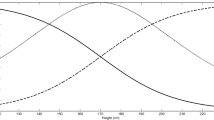Abstract
In applications of fuzzy techniques to several practical problems – in particular, to the problem of predicting passenger flows in the airports – the most efficient membership function is a sine function; to be precise, a portion of a sine function between the two zeros. In this paper, we provide a theoretical explanation for this empirical success.
Access this chapter
Tax calculation will be finalised at checkout
Purchases are for personal use only
Similar content being viewed by others
References
Belohlavek, R., Dauben, J.W., Klir, G.J.: Fuzzy Logic and Mathematics: A Historical Perspective. Oxford University Press, New York (2017)
Klir, G., Yuan, B.: Fuzzy Sets and Fuzzy Logic. Prentice Hall, Hoboken (1995)
Li, Z., Bi, J., Li, Z.: Passenger flow forecasting research for airport terminal based on SARIMA time series model. In: IOP Conference Series: Earth and Environmental Science, vol. 100, p. 012146 (2017)
Liu, L., Chen, R.-C.: A novel passenger flow prediction model using deep learning methods. Transp. Res. Part C, Emerg. Technol. 84, 74–91 (2017)
Liu, X., Huang, X., Chen, L., Qiu, Z., Chen, M.: Prediction of passenger flow at sanya airport based on combined methods. In: Zou, B., Li, M., Wang, H., Song, X., **e, W., Lu, Z. (eds.) ICPCSEE 2017. CCIS, vol. 727, pp. 729–740. Springer, Singapore (2017). https://doi.org/10.1007/978-981-10-6385-5_61
Mendel, J.M.: Uncertain Rule-Based Fuzzy Systems: Introduction and New Directions. Springer, Cham (2017). https://doi.org/10.1007/978-3-319-51370-6
Miyajima, K., Ralescu, A.: Spatial organization in 2D segmented images: representation and recognition of primitive spatial relations. Fuzzy Sets Syst. 65(2–3), 225–236 (1994)
Munasingha, K., Adikariwattage, V.: Discrete event simulation method to model passenger processing at an international airport. In: IEEE Proceedings of the 2020 Moratuwa Engineering Research Conference MERCon, Moratuwa, Sri Lanka, 28–30 July 2020, pp. 401–406 (2020)
Nguyen, H.T., Walker, C.L., Walker, E.A.: A First Course in Fuzzy Logic. Chapman and Hall/CRC, Boca Raton (2019)
Novák, V., Perfilieva, I., Močkoř, J.: Mathematical Principles of Fuzzy Logic. Kluwer, Boston (1999)
Viaña, J.: Explainable AI Process for Passenger Flow Prediction at the Security Checkpoint of the Airport, United States Patent and Trademark Office. Approved US Provisional Patent. Application No. 63/232,782 filed on 13 August 2021
**e, G., Wang, S., Lai, K.K.: Short-term forecasting of air passenger by using hybrid seasonal decomposition and least squares support vector regression approaches. J. Air Transp. Manage. 37, 20–26 (2014)
Zadeh, L.A.: Fuzzy sets. Inf. Control 8, 338–353 (1965)
Acknowledgments
This work was supported by:
\(\bullet \) Fellowship for Postgraduate Studies in North America from “La Caixa” Banking Foundation, ID 100010434, grant LCF/BQ/AA19/11720045,
\(\bullet \) Ohio State Excellence Scholarship & Recognition Grant, sponsored by the Hispanic Chamber of Commerce, Cincinnati, Ohio, USA,
\(\bullet \) the Airport Cooperative Research Program Graduate Research Award, sponsored by the Federal Aviation Administration, administered by the Transportation Research Board and The National Academy of Sciences, and managed by the Virginia Space Grant Consortium.
\(\bullet \) the National Science Foundation grants 1623190 (A Model of Change for Preparing a New Generation for Professional Practice in Computer Science), and HRD-1834620 and HRD-2034030 (CAHSI Includes),
\(\bullet \) the AT &T Fellowship in Information Technology,
\(\bullet \) the program of the development of the Scientific-Educational Mathematical Center of Volga Federal District No. 075-02-2020-1478, and
\(\bullet \) grant from the Hungarian National Research, Development and Innovation Office (NRDI).
The authors are very thankful to the anonymous referees for valuable suggestions.
Author information
Authors and Affiliations
Corresponding author
Editor information
Editors and Affiliations
Rights and permissions
Copyright information
© 2023 The Author(s), under exclusive license to Springer Nature Switzerland AG
About this paper
Cite this paper
Holguin, S., Viaña, J., Cohen, K., Ralescu, A., Kreinovich, V. (2023). Why Sine Membership Functions. In: Dick, S., Kreinovich, V., Lingras, P. (eds) Applications of Fuzzy Techniques. NAFIPS 2022. Lecture Notes in Networks and Systems, vol 500. Springer, Cham. https://doi.org/10.1007/978-3-031-16038-7_9
Download citation
DOI: https://doi.org/10.1007/978-3-031-16038-7_9
Published:
Publisher Name: Springer, Cham
Print ISBN: 978-3-031-16037-0
Online ISBN: 978-3-031-16038-7
eBook Packages: Intelligent Technologies and RoboticsIntelligent Technologies and Robotics (R0)




